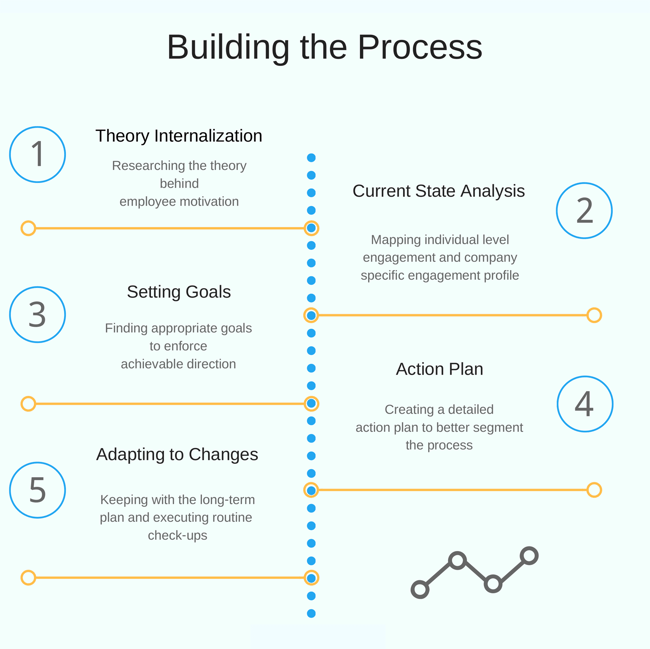Building a Process for Employee Engagement
The vast range of benefits that employee engagement has to offer are common knowledge. So why are so many companies struggling to actually unlock those benefits? In our experience, the answer usually lies in the nature of the efforts. The most successful companies have been able to make ensuring engagement a part of everyone's job. This transition isn't easy and it takes a very focused effort to make it a reality.
Employee engagement basically means building sustainable relationships with your employees to improve the workplace quality and thus increase individual motivation and dedication. It’s a managing angle that focuses more on effectiveness than efficiency, primarily aiming to build collective inner motivation towards the brand and mission.
Ultimately good employee engagement comes down to conveying values to employees, which can be broken down into two aspects: how the values are conveyed and who conveys them. Although it is important to have qualified charismatic individuals in management, there is an equally important process behind applying employee engagement strategically. The primary goal of this process is building a long-term foundation for individual growth, not focusing on monetary ‘quick fixes’ that lack cost-efficiency.

The 5 key steps for building the process
While the techniques and methods needed to energize employees vary per company, the steps to take to come up with the plan or the process are usually the same. Building a process for employee engagement isn't very complicated but it'll still require quite a bit of footwork. With a summarization these steps can be broken down to the following:
- Understanding the theory behind employee motivation
- Understanding your current state
- Setting appropriate goals to lock on a direction
- Creating an action plan to assert concrete change
- Adapting to changes and preparing for what lies ahead
The order of these stages represent a logical approach in most cases. However, these are guidelines to case-sensitive situations and thus aren’t etched in stone. Now, let’s scratch beneath the surface and find out what each stage entails.
Understanding the theory
To start off, for understanding how to build a process for employee engagement, you must first understand what is required for people to be engaged. For this, we must dive to the subconscious parts of the human mind and take a look at the requirements for inner motivation.
Probably the most famous representation of these requirements is called Maslow’s hierarchy of needs; a hierarchical representation of what basic needs should be nurtured in order to increase inner-motivation. The figurative pyramid starts from physiological needs, which is the bottom layer, going through: safety, belonging and esteem, before reaching self-actualization at the top of the pyramid. Most of the ‘essentials’ from the lower levels are things many of us doing knowledge work typically have in order. Still, way too many companies expect their employees to be engaged if they're just being paid well.
To unlock the individual capacity for self-actualization: a state in which a person is no longer weighed down by any unnecessary stressors and can thus focus on their inner ambitions, said person should feel like they belong at their workplace and like their input matters. This can be achieved through a supportive transparent work environment. After all, self-actualization is the purest source of motivation as it is completely uninhibited.
Picture the difference between a long-chained carbohydrate like whole-wheat bread, and a short-chained like processed sugar. The whole-wheat product keeps you nourished longer but also takes longer to affect. The processed sugar affects quickly but soon results in a crash, only to be craved more. Now imagine the whole-wheat bread as an internal motivator and the processed sugar as an external. Internal motivators slowly increase motivation at the foundation, resulting in a long-lasting effect, whereas external ones offer fast spikes in motivation that are often short lived. The same logic can be applied to workplace motivators. It’s much more effective to focus on giving ongoing positive feedback and inclusion on meaningful decisions rather than seldom costly field trips or other extravagances.
Understanding your current state
Mapping your current state entails finding out where you’re currently at and what the root causes for that state are. This should obviously be done very early on in the process to avoid derailing and focus on the currently most prolific course of action.
Find out the special characteristics of your industry or company culture. In terms of employee engagement, what applies for one company doesn’t necessarily apply for another. Knowing what makes your situation different allows you to mold your employee engagement process accordingly. Giving time off during work hours for personal pet projects may feed innovational growth for a software startup, but the same practice might not be a feasible solution for employees working on an assembly line.
Depending on company size, charting your current level of engagement may be a time-consuming process, but one that's always worth it on the grander scale. You must find out, how engaged your employees currently feel and what exactly makes them tick. Many employees tend to be on different starting points in terms of how they should be engaged. For example, if someone doesn’t have Maslow’s bottom level physiological needs nurtured, it requires a very different approach to ultimately achieve self-actualization. For more examples on this, read our earlier post on the sources of employee motivation.
Mapping the current engagement level of each employee takes resources and patience, but is a key ingredient in finding out which areas have an especially negative impact on performance and satisfaction. It helps aim focus on where improvement is required and where not. Sniping marked units is much more effective than randomly scouring for a needle in a haystack.
Setting appropriate goals
As employee engagement is a vague concept, it’s quite important to establish a direction through accomplishable goals. Having measurable goals creates a concrete vision of what you ultimately aim to achieve.
However, don’t grab every issue you can find and set their repairs as your goals. Instead, pick a few important goals from the challenges most impacting your business and focus on them.
Imagine yourself running a business in the fast food industry. Odds are your biggest employee related challenge would be high turnover. Improving employee satisfaction would probably be a logical course of action in increasing employee retention. However, if you’re doing knowledge work, pure satisfaction might no longer be enough. In that case, you should aim to also measure the effectiveness and creative capabilities of your employees, as both the quality and quantity of their output will have a dramatic effect on your business results.
Creating an action plan
The action plan amounts to the actual implementation process of the companys's core values. The fundamental building blocks of trust, transparency, integrity and commitment are essential for any well performing team. However, depending on your culture, there might also be additional core values. Making these values a reality, as opposed to remaining as just nice words, always requires time, resources and patience.
In order to achieve a set goal, create a plan that outlines the unknown variables you still have yet to figure out. This helps you work towards those goals systematically, one little action at a time. It also assists in creating a time-frame for said goals to be achieved, adding predictability and relief to the equation, helping you to notice early on if a course correction is in order. Approach it the same way you would a complex math problem. Break it down to segments and solve it piece by piece, don't let it overwhelm you.
First understanding what motivates your employees, charting your current state and having a clear vision, makes it much easier to create a systematic action plan that actually drives results. Starting the whole process off with a plan to implement concrete change can easily lead to snap decisions lacking in proper research, which may possibly even result in increased disengagement. There's no silver bullet when it comes to employee engagement, just a lot of decisions that need to be made on all levels of the organization.
Adapting to changes
All in all, employee engagement is about sustainable company development, which always takes some time to implement systematically. Don’t be impatient and wait for it to happen overnight. The best results are achieved through a methodic approach, removing one hurdle at a time.
The further you get in the process the more your company and employees will have changed. Adapting to this change is crucial in terms of yielding the full benefits of the work put in. Both your goals and the process itself will need to adapt to the new reality. Take a breather at certain intervals and check how much change has happened and how it’s been received. This can be done by having regular, for example, quarterly check-ups with your team leaders to find out if they’ve noticed a change in behavior or overall motivation. These check-ups make it easier to find early on if employee engagement has taken root and induced change towards the right direction.
Pixar
Pixar is a great example of a company where engaged employees have created a great company with a culture to match. Through transparency and a systematic approach to removing hurdles for innovation, they have created a fearless community of free thinkers where self-actualization has become a reality. To take a closer look at their process of employee engagement, we’ll take a look at “Notes Day”: a once a year event where everybody’s primary focus in on improving the way they work as a company.
With decreases in production budgets, the pressure was building at Pixar to keep up their terrific record of one hit movie after another. That pressure had lead to a situation where fear was starting to take hold of people and affect the culture. The leaders of Pixar adjusted accordingly.

The leaders decided to create a day where everyone can get involved in addressing ideas and topics promoting cost-efficiency. This is done by groups of employees in one-hour meetings discussing outside-the-box methods to achieve this goal. They chose not to attempt fixing the problems through micro-managing but instead let transparency spark an open dialogue.
A channel was left open for employees to resolve the issue themselves through the collective power of their innovative workforce. They knew that to permanently decrease their budgets, they'd need to make a lot of progress on many fronts, which would never have been possible with a top-down approach. Not only did the individual expertise, effort lead to great ideas for improving cost-efficiency, it returned the excitement and sense of ownership that had been starting to fade for many of the employees.
Pixar’s “Notes Day” is a great example of involving employees in the company’s direction. At its first implementation, it might’ve been considered risky by some parties due to the fact that, for a whole day, all employees focus on just this one united agenda, the cost of which is obviously stellar. Pixar, however, realized the value of investing in sustainable long-term development, such as this, and it has paid off.
Final thoughts
Don’t focus on forcing change, but rather approach it systematically. Educate yourself on what is required for each individual to be unshackled by unnecessary stressors and focus on helping them remove those shackles. Employee engagement is not about performance improvement or manipulation, but rather an approach of emotionally intelligent understanding.
Placing yourself in the shoes of your employees and finding out where the shoe pinches. By doing comprehensive research you have a better probability of systematically committing to a process that yields permanent change in both attitude and commitment.
Don’t let the scale of the challenges scare you. There's a lot of work to be done but you're not alone. Focus on doing the footwork to get every team leader onboard when you're to roll out the plan. They are, afterall, the people most affecting the engagement of their teams.
Interested in Innovation and Leadership?
Subscribe to our blog to get the latest stories on innovation, leadership and culture straight to your inbox.









